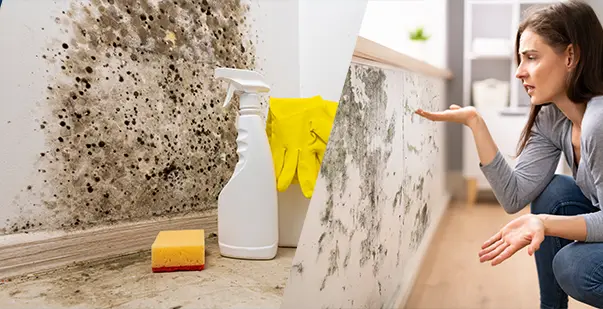Have you ever noticed dark spots, fuzzy growths, or musty smell lurking in the corners of your home, especially in damp spaces like the bathroom or basement? Recent studies found that approximately 70% of homes worldwide, and at least 45 million buildings in the US, have some mold, with 16% of indoor air samples containing Stachybotrys (a filamentous fungus found in indoor environments).
Now, before you panic and grab the bleach, take a closer look. That suspicious spot could be black mold, mildew, or just a harmless stain. But how do you tell them apart? And more importantly, which ones pose a risk to your health and home? Being aware of black mold vs mildew helps you identify the problem and implement the best way to handle the situation and ensure your health and home safety. So, keep reading to learn what mold looks like, what are different types of molds, and how to deal with them.
What Do You Need to Know About Molds?
Molds are tiny fungi that grow in damp, warm, and humid places, such as bathrooms, basements, kitchens, or anywhere with moisture. They spread through invisible spores in the air and can grow on walls, ceilings, carpets, and even furniture. While some molds are harmless, others can trigger allergies, breathing problems, or serious health issues, especially black mold (Stachybotrys chartarum).
Molds come in different colors, black, green, white, or even orange, and often have a musty smell. They thrive on moisture, so a leaky pipe or poor ventilation gives them the perfect place to grow. If you’ve ever noticed fuzzy patches or spots that keep coming back, it might be mold.
The key to mold control is moisture control. Spotting it early and fixing leaks or improving airflow can stop it from spreading. If mold covers a large area or causes health symptoms, it’s best to get professional help for removal.
What Are The Different Types of Mold?
Mold can be found both indoors and outdoors and can grow on various surfaces. Common ones include black mold, Aspergillus, Cladosporium, and Penicillium. Each type looks different, grows in specific places, and can affect your health in different ways. Let us explore some common types of molds:
Cladosporium
Often found in air conditioning units, carpets, and fabrics, this mold is typically black or olive-green. It can thrive in both cool and warm environments and is known to cause allergic reactions, especially in individuals with respiratory issues.
Aspergillus
Aspergillus is one of the most common types of indoor mold and can be found growing on food, carpets, or even in your home’s heating, ventilation, and air conditioning (HVAC) system. It has a variety of strains, some of which are beneficial (used in food production), while others can cause health problems like lung infections or allergic reactions.
Penicillium
This mold is often blue or green in appearance and is frequently found in damp environments such as water-damaged materials, like carpets and insulation. Penicillium molds can trigger asthma and allergies, especially in sensitive individuals.
Fusarium
Fusarium is a fast-growing mold that usually appears as pink, red, or white and thrives in areas with high humidity. It is one of the bathroom mold types and is also found in basements. Fusarium can produce mycotoxins, which are toxic substances that can harm your health.
Stachybotrys Chartarum (Black Mold)
Stachybotrys chartarum, commonly known as black mold, is one of the most toxic indoor molds. It typically grows in damp, cellulose-rich areas like drywall or wood. Its texture is slimy or velvety and dark greenish-black. Unlike mildew, black mold poses serious health risks, especially for people with respiratory issues.
Read More: What is RCRA Hazardous Waste Training?
Black Mold vs. Mildew: What's the Real Difference?
You’ve probably heard people call any dark wall stain “mold” or “mildew” as if they're the same thing. While they might look similar at first glance, black mold and mildew are completely different troublemakers with very different consequences. Let’s find out how they differ:
Black Mold: The Toxic Intruder
Black mold, or Stachybotrys chartarum, is notorious for its dark green or black color. You may notice it in areas with leaky pipes, roof damage, or flooding. It often grows on materials like drywall, wood, and insulation. Black mold thrives in moist, poorly ventilated areas, especially where water damage has occurred.
The mold produces mycotoxins, which can lead to a variety of health issues, particularly respiratory problems. For individuals with weakened immune systems, allergies, or asthma, black mold can cause more severe reactions, including respiratory distress and sinus infections.
Mildew: The Lesser Evil, But Still a Nuisance
Mildew is often considered a milder form of mold, but don’t be fooled; it still poses risks to your health. Mildew typically appears as a white or light gray powder on surfaces. Unlike black mold, mildew is usually confined to the surface of materials and doesn’t penetrate deeply. It thrives in warm, moist environments but is generally easier to clean than black mold.
While mildew isn’t typically as dangerous as black mold, it can still trigger health problems, especially for individuals sensitive to allergens. Prolonged exposure can lead to breathing issues, coughing, and throat irritation.
Here’s an overview key differences between black mold vs mildew:
What to Do When You Spot Mold or Mildew
If you detect mold in your home or office, addressing the issue promptly will minimize health risks and prevent further damage. The longer mold remains untreated, the greater the potential for health complications and structural damage. Follow these steps to get rid of mold or mildew:
Identify the Mold Type
Mold usually shows up as slimy black, green, or brown spots. However, mildew is lighter, white, gray, or yellow, and looks powdery. Identifying the type helps you choose the right cleanup method and avoid unnecessary health or structural damage.
Assess the Extent of the Infestation
Determine the size and location of the mold growth. If the mold covers a small area (less than 10 square feet), you can clean it yourself. However, if the mold has spread to a larger area or is present in hidden spaces (such as behind walls or under flooring), professional mold remediation services may be required.
Address the Root Cause
Mold grows due to moisture, so it's essential to fix any water issues to ensure your home health. Fix leaks, improve ventilation, or patch roofs to stop mold at the source. Drying out damp spaces is your first defense against any future infestations, no matter the type of mold
Clean or Remove Contaminated Material
If the mold is on a non-porous surface (like tile or glass), you can clean it using a mold-killing cleaner, such as a mixture of water and bleach or a store-bought mildew remover. For porous materials (like drywall or carpet) that have been significantly damaged by mold, replacement may be necessary. In some cases, items that cannot be properly cleaned may need to be disposed of to prevent further contamination.
Consider Professional Help
If the mold problem is extensive or you're dealing with black mold, it's best to call in professional mold remediation experts. These specialists have the necessary tools, experience, and protective gear to safely remove every bathroom mold type and address underlying moisture issues.
Read More: Which Industries Require Hazmat Certification?
Keep Your Home and Health Safe With Right Mold Prevention Tips!
Your home is your sanctuary, and ensuring it remains mold-free is essential for both your health and comfort. Mold growth in your home is more than just an aesthetic issue. It's a health risk that should be taken seriously. Being aware of the differences between black mold vs mildew and taking the necessary precautions can help keep your home safe and healthy.
Stay proactive by keeping humidity levels under control, fixing leaks, and regularly cleaning your home. If mold or mildew does appear, act quickly to remove it and restore a safe living environment for you and your family. If you're unsure about mold types or health risks, don't hesitate to consult a professional to ensure your home remains mold-free.
References





